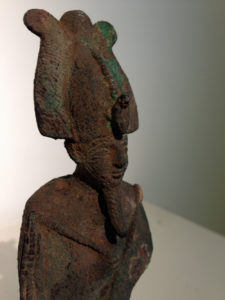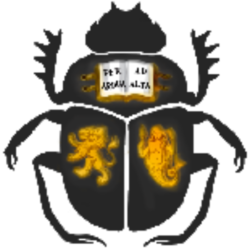Osiris: The mythological origins of mummification
By Stacey Anne Bagdi, West Midlands Egyptology Society
Osiris, the ancient Egyptian god of the dead, was believed to have been the first mummified being. The myth of Osiris narrates the mythological origins of mummification and subsequent resurrection, and may have provided consolidation to those facing death (O’Connor 2009: 37). What follows is a brief account of these beginnings and how Osiris became the model for all Egyptians; the mummy par-excellence.
Osiris, along with sisters Isis and Nephthys and brother Seth, were the offspring of the gods Geb and Nut (Taylor 2001: 25). As part of this Heliopolitan Cosmology he was regarded as one of the earliest kings of a united Egypt. His earthly and divine kingship was recognised in depictions through iconic features such as his Atef crown with ureaus, which are both clearly visible in ECM619 and also the holding of the crook and flail across his chest as seen in ECM622 and X725. In death, Osiris was shown as a mummified body (mummiform) with visible hands and face, and his skin was usually green or black; colours associated with both resurrection and fertility.

Left: Headless statuette of Osiris. Late Period-Ptolemaic Period, Unknown provenance. ECM622, Eton College. Right: Head of Osiris wearing the Atef crown, royal beard and ureaus. Late Period-Ptolemaic Period. Unknown provenance. ECM619, Eton College.
Osiris’ name and allusions to his mythological origins first appear in the Pyramid Texts of the late Old Kingdom (Griffiths 1980: 41). However, no continuous account of the myth has been preserved. The most complete account is known only from Plutarch (c. AD 120) who based his account on several originally independent ancient Egyptian versions (O’Connor 2009: 37). Here follows a brief account of the death and subsequent mummification of Osiris:
1. Seth’s first attack on Osiris: Seth, jealous of his brother’s prosperous reign on Earth, plotted to kill him by devising a clever ruse to trap Osiris. During a banquet, Seth offered a beautiful chest to anyone that could fit inside it. When Osiris laid down in the chest, Seth and his accomplices slammed it shut and threw it into the river Nile. (Plutarch, 13).
2. Osiris in Byblos: Isis, the distraught widow (and sister) of Osiris, goes in search of Osiris’ body (Plutarch, 14) and discovered that it had washed up on the shore of Byblos, where a tree had grown around it. Although the king of Byblos had taken the trunk of this tree as a support pillar for his palace roof (Plutarch, 15), Isis successfully petitioned for its return (Plutarch, 16).
3. Seth’s second attack: Seth found the coffin whilst hunting by night and, after recognising it was Osiris, cut the body into fourteen pieces and scattered them across Egypt. When Isis heard of this she enlisted the aid of her sister Nephthys and the pair sought out to collect the dismembered body (Plutarch, 18).It is Isis and Nephthys. They have come in search of their brother Osiris (PT. 535)
 4. Osiris’ mummification and resurrection: Isis and Nephthys managed to recover every part of Osiris’ body except his phallus, which was eaten by a fish in Oxyrhynchus. Isis magically replaced his missing member (Plutarch, 18) and subsequently conceived their son, Horus. The jackal-headed god Anubis finally embalmed and wrapped Osiris’ body to create the first mummy of Ancient Egypt. After being embalmed, Osiris was restored to life with the aid of Isis’ magic. His eventual resurrection as god of the underworld is recorded in the Pyramid texts. Osiris…this King lives; he is not dead, this King is not dead. He has not perished, this King has not perished… (PT. 167a-d)
4. Osiris’ mummification and resurrection: Isis and Nephthys managed to recover every part of Osiris’ body except his phallus, which was eaten by a fish in Oxyrhynchus. Isis magically replaced his missing member (Plutarch, 18) and subsequently conceived their son, Horus. The jackal-headed god Anubis finally embalmed and wrapped Osiris’ body to create the first mummy of Ancient Egypt. After being embalmed, Osiris was restored to life with the aid of Isis’ magic. His eventual resurrection as god of the underworld is recorded in the Pyramid texts. Osiris…this King lives; he is not dead, this King is not dead. He has not perished, this King has not perished… (PT. 167a-d)
Left: Standing mummiform statuette of Osiris. Late Period-Ptolemaic Period. Unknown provenance. X725, RCC-UoB. (download 3D-model pdf here).
All ancient Egyptians hoped to be reborn into the afterlife and to be introduced to Osiris. In emulation of his myth the deceased were even likened to Osiris and referred to as the Osiris NN, and thus received the same protection as was afforded the god in death (Taylor 2001: 27). The methods of mummification and the rituals of burial in ancient Egypt had their origins in this archetype, and the accompanying essays in this virtual exhibition aim to explore Egyptian attitudes towards death further and illuminate the mysteries of resurrection.
Further reading:
Faulkner, R. O. 1969. The Ancient Egyptian Pyramid Texts. Oxford.
Griffiths, J. G. 1980. The origins of Osiris and his cult. Leiden.
O’ Connor. D. 2009. Abydos: Egypt’s First Pharaohs and the Cult of Osiris. London.
Plutarch, De Iside et Osiride, trans. J. G. Griffiths (University of Wales Press 1970).
Taylor, J. H. 2001. Death and the Afterlife in Ancient Egypt. London.
